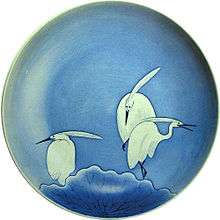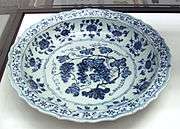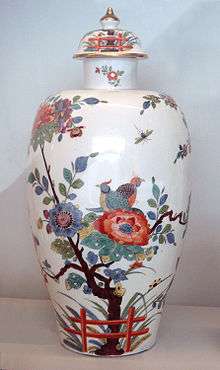Imari porcelain
Imari porcelain (伊万里焼) is the name for Japanese porcelain wares made in the town of Arita, in the former Hizen Province, northwestern Kyūshū. They were exported to Europe extensively from the port of Imari, Saga, between the second half of the 17th century and the first half of the 18th century. The Japanese as well as Europeans called them Imari. In Japanese, these porcelains are also known as Arita-yaki (有田焼). Imari or Arita porcelain has been continuously produced up through the present day.
Characteristics
Though there are many types of Imari, Westerners' conception of Imari in the popular sense is associated only with a type of Imari produced and exported in large quantity in mid-17th century. This type is called Kinrande. Kinrande Imari is colored porcelain with cobalt blue underglaze and red and gold overglaze. The color combination was not seen in China at that time. Traditional Ming dynasty color porcelain used dominantly red and green, probably due to scarcity of gold in China, whereas gold was abundant in Japan in those days. The subject matter of Imari is diverse, ranging from foliage and flowers to people, scenery and abstractions. Some Imari design structures such as kraak style were adopted from China, but most designs were uniquely Japanese owing to the rich Japanese tradition of paintings and costume design. The porcelain has a gritty texture on the bases, where it is not covered by glaze. There is also blue and white Imari. Kakiemon style Imari is another type of Imari, but it tends to be categorized separately in Europe.
History

"Imari" was simply the trans-shipment port for Arita wares. It was the kilns at Arita which formed the heart of the Japanese porcelain industry.
Arita's kilns were set up in the 17th century, when kaolin was discovered in 1616 by the immigrant Korean potter, Yi Sam-pyeong (1579–1655). (He may also be known by the name, "Kanage Sambei".) Yi Sam-Pyeong, along with his extended family of 180 persons. He was kidnapped by Japanese forces during the occurrence of Japanese invasions of Korea. After Yi Sam-Pyeong's discovery, his kilns began to produce revised Korean-style blue and white porcelains, known as "Shoki-Imari".
In the mid-17th century there were also a lot of Chinese refugees in Northern Kyushu due to the turmoil on Chinese continent, and it is said one of them brought coloring technique to Arita. Thus Shoki-Imari developed into Ko-KutaniImari. Ko-Kutani was produced around 1650 for both export and domestic market. Blue and white porcelain continued to be produced and they are called Ai-Kutani. Ko-Kutani Imari for the export market usually adopted Chinese design structure such as kraak style, whereas Ai-Kutani for the domestic market were highly unique in design and are accordingly valued very much among collectors.

Ko-Kutani style evolved into Kakiemon style Imari, which was produced for about 50 years around 1700. Imari achieved its technical and aesthetic peak in Kakiemon style, and it dominated European market. Blue and white Kakiemon is called Ai-Kakiemon. Kakiemon style transformed into Kinrande in the 18th century. Kinrande used blue underglaze and red and gold overglaze, and later some other colors.
Imari began to be exported to Europe because the Chinese kilns at Ching-te-Chen were damaged in the political chaos and the new Qing dynasty government stopped trade in 1656–1684. Exports to Europe were made through the Dutch East India Company, but the designation "Imari porcelain" in Europe connotes Arita wares of mostly Kinrande Imari.
Export of Imari to Europe stopped in mid-18th century when China began export to Europe again, since Imari was not able to compete against China due to high labor cost. By that time, however, both Imari and Kakiemon style were already so popular among Europeans, Chinese export porcelain copied both Imari and Kakiemon style, which is called Chinese Imari. At the same time, European kilns, such as Meissen also tried to copy Imari and Kakiemon.
Export of Imari surged again in late 19th century (Meiji era) when Japonism flourished in Europe. Thus in western world today, two kinds of Imari can be found: that exported in the mid-Edo period, and that exported in the Meiji. From the viewpoint of collectors these two types are completely different, though Kinrande appearances are similar.
Nabeshima is the other category of Imari. Nabeshima is a kind of Imari produced in Lord Nabeshima's official kiln only for the official use of Lord Nabeshima throughout Edo period. As such, Nabeshima is characterized by its distinctively noble design.
Imari style

Though sophisticated wares in authentic Japanese styles were being made at Arita for the fastidious home market, European–style designations of Arita porcelain were formed after blue and white kraak porcelains, imitating Chinese underglaze "blue-and-white" wares, or made use of enamel colors over underglazes of cobalt blue and iron red. The ware often used copious gilding, sometimes with spare isolated sprigged vignettes, but often densely patterned in compartments. There were two quite different styles in these wares.[1] Globular Imari teapots with swan-necked spouts helped establish the classic European form for these new necessities of life.
Kakiemon style

Early experiments with overglaze colored enamels at Arita are associated with Sakaida Kakiemon (1596–1666), whose name is memorialized in "Kakiemon" ware, the other main tradition in lightly fired overglaze enamel decors. Dutch traders had a monopoly on the insatiable export trade, the first large order being placed at Arita by the Dutch East India Company in 1656. The trade peaked in the late 17th century and was slowly replaced by Chinese kilns in the early 18th century; it ended in 1756, as social conditions in China settled with the full establishment of the Qing Dynasty. Imitating Arita designs, fine "Chinese Imari" export wares were produced in the 18th century, eclipsing the original Japanese exports.
Imari patterns, as well as "Kakiemon" designs and palette of colors, influenced some early Orientalizing wares produced by the porcelain manufactories at Meissen, Chantilly, or later at Vincennes.
European centers imitated the style of "Imari" wares, initially in faience at Delft in the Netherlands, and in the early 19th century at Robert Chamberlain's factory at Worcester.[2]
See also
- Japanese pottery
- Kakiemon
- Victoria and Albert Museum which has a collection of Imari Porcelain
References
- ↑ Oliver Impey, "Japanese export art of the Edo Period and its influence on European art", Modern Asian Studies 18.4, Special Issue: Edo Culture and Its Modern Legacy (1984, pp. 685–697) p. 695. "On the one hand a gaudy, brash brightly coloured and highly decorated style, the Imari style."
- ↑ See Worcester porcelain.
- Henry Trubner, "Japanese Ceramics: A Brief History", in Seattle Art Museum, Ceramic Art of Japan, 1972.
- Tsuneko S. Sadao and Stephanie Wada, Discovering the Arts of Japan: A Historical Overview, 2003
Further reading
- Takeshi, Nagatake (1979). Japanese ceramics from the Tanakamaru collection. New York: The Metropolitan Museum of Art.
External links
| Wikimedia Commons has media related to Imari porcelain. |
| ||||||||||
|



